The simplified DUTCH Report has arrived, and current DUTCH Providers are eligible for up to 5 DUTCH Complete or DUTCH Plus test kits for 50% off. Learn more and claim this offer!
DUTCH Report Enhancements
Hilary Miller, ND
Beginning on October 15, 2025, Precision Analytical will release the newest version of the DUTCH Test. This is the report’s most significant update since the debut of the DUTCH Test in 2013. The newest DUTCH report highlights the key components of the patient’s hormonal health that the DUTCH Test has been reporting for over a decade: Hormone levels and hormone metabolism.
This update reduces the report review time by putting the most actionable insights on the front page, with access to expanded results on subsequent pages, and clarifies the key clinical takeaways in a new “About Your Results” section at the end of the report.
This update is reflected in the DUTCH Complete, DUTCH Plus, and all our smaller panels (excluding the Cycle Map).
In addition, we have developed an interpretive framework to streamline how you interpret a patient’s DUTCH results and feel confident that you are capturing the most relevant and impactful insights from the report. This is called the DUTCH Dozen, and you can read more about that here.
Reading a report with the DUTCH Dozen helps you understand a patient’s unique hormone story more quickly. It also gives you a single page to review with your patient, making it easier to discuss their hormone health.
Report enhancements include:
- An expanded Hormone Summary Page:
- Clear reporting of parent hormone levels alongside metabolism patterns
- Estrogen metabolism Phase 1 and 2 Sliders
- Androgenic 5a-Metabolism Slider
- Free Cortisol diurnal pattern graph improvements (on Hormone Summary AND Expanded Cortisol pages)
- Patient-specific collection times have been added to X axis
- Free cortisol plot point colors show in or out of range
- Additional points plotted on the pattern, including a mid-sleep sample if collected for the DUTCH Complete
- Calculated CAR in table (for DUTCH Plus)
- Organic Acid Alert section highlighting any results requiring attention
- Changes to the Expanded Sex Hormone Graphical page
- New: 5a-Metabolism (P4) Progesterone Slider
- The Phase 1 Estrogen Metabolism pie chart is retiring
- The Total DHEA Production dial has been added to the androgen section
- “About Your Results” or The DUTCH Dozen: An interpretation framework to simplify reading the report
New Layout: Hormone Testing Summary
The changes begin with the Hormone Testing Summary (page 1).
This page has historically shown the key sex and adrenal hormones and metabolites from the three hormone groups: Estrogen (and progesterone for females), androgens, and cortisol. Starting in October, the Hormone Testing Summary will reorient the three hormone groups in rows, with two columns: parent hormone levels on the left, and hormone metabolism on the right (see below).
This updated Summary Page includes a new Estrogen Metabolism section, showing phase 1 and 2 estrogen metabolism ratios, the 5a-Metabolism slider for androgens, and new features, including the addition of patient collection times on the x-axis, on the Free Cortisol Diurnal Pattern Graph. The new Hormone Testing Summary will also include a new OATs section, highlighting organic acid results that may need attention at the bottom of the page.
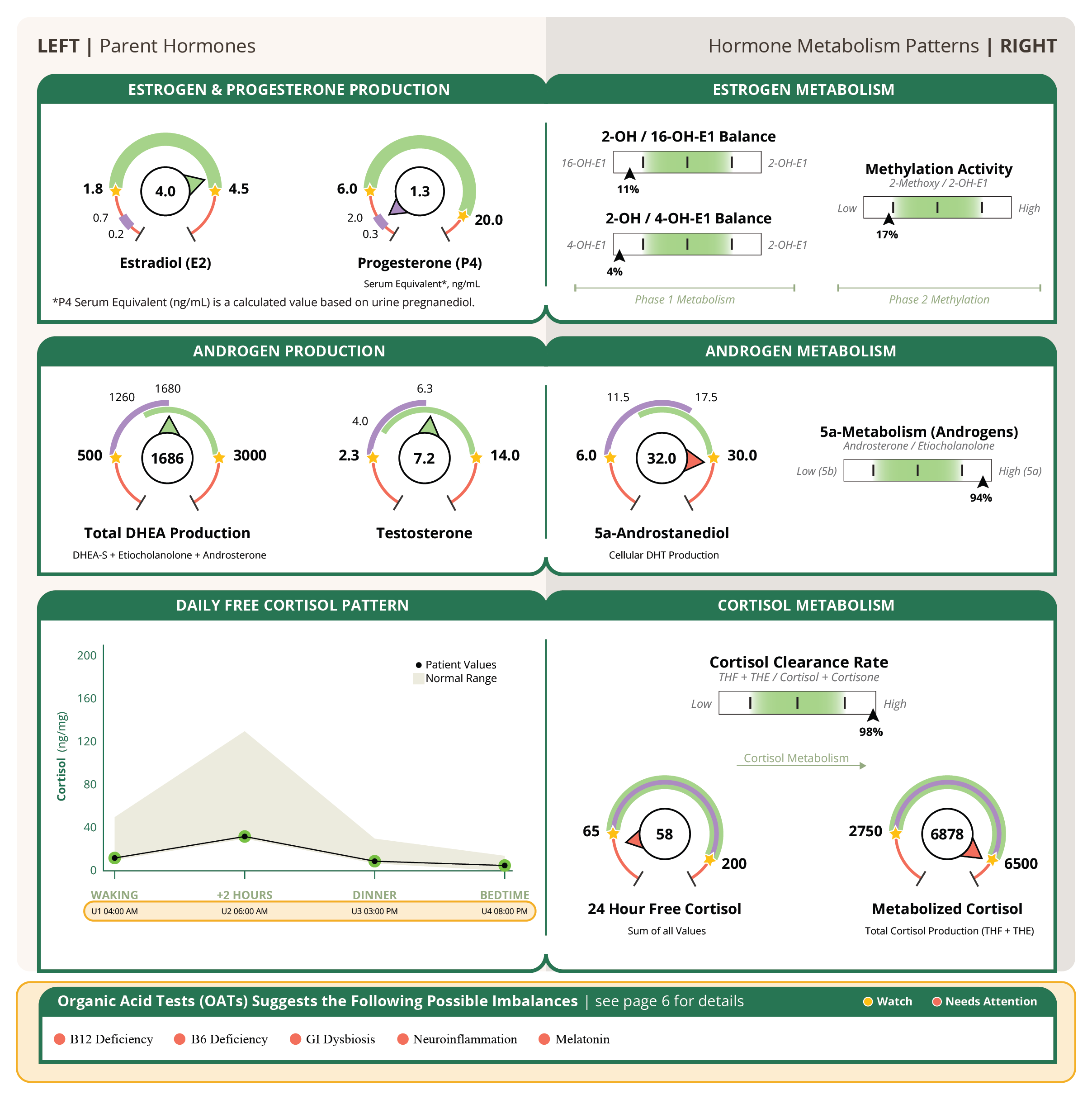
New: Page Order
The next change you will notice is the page order. The graphical pages for sex hormones and adrenal hormones will now be pages 2 and 4 of the report, respectively. The organic acids page remains page 6. The two list-style pages for sex hormone and adrenal hormone results will still be in the report, each following its graphical page (pages 3 and 5, respectively).
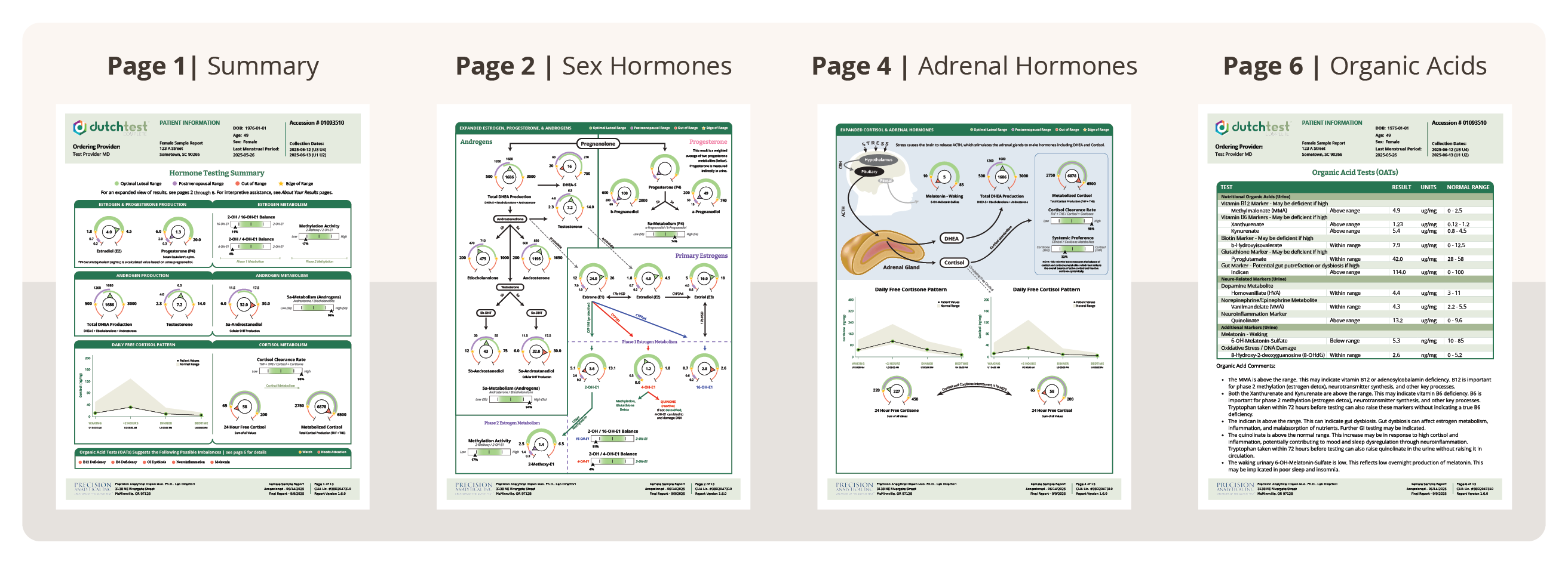
The next three pages, titled “About Your Results”, will be described later in this article - keep reading!
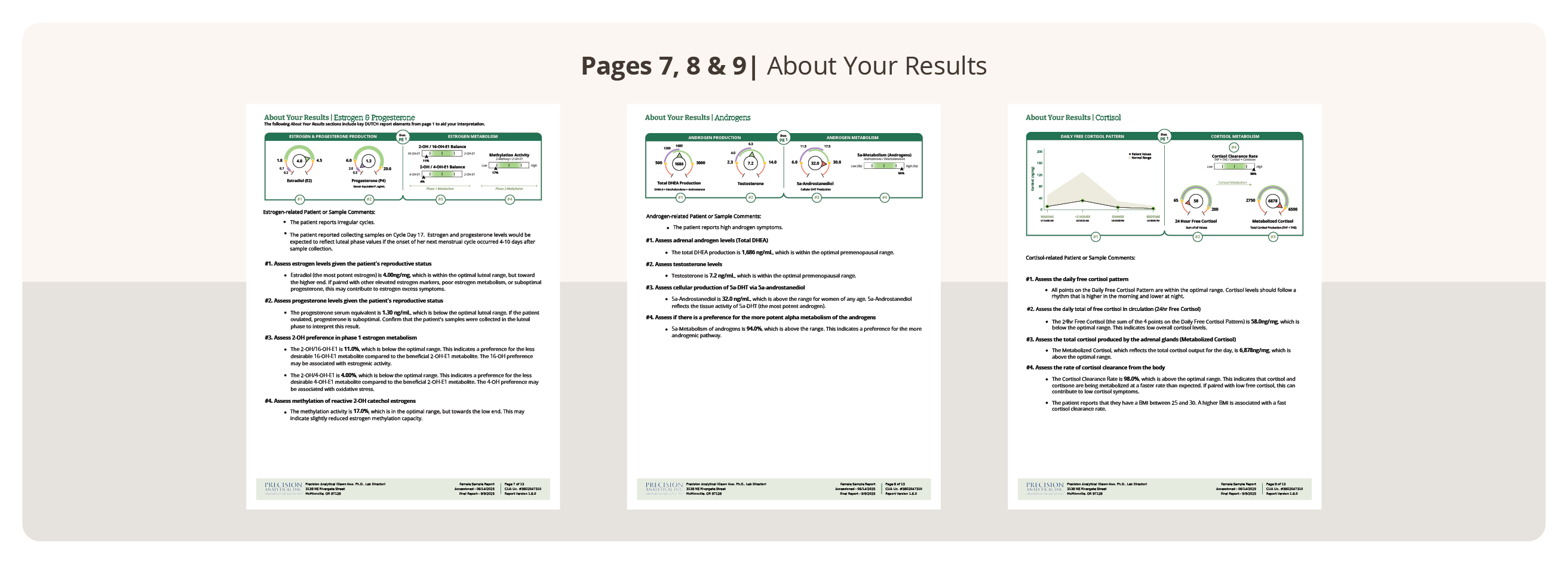
We encourage providers to focus on the Hormone Summary Page and the About Your Results interpretive support pages as they move through report interpretation and introduce results to their patients. You can always refer to the expanded, detailed pages and the About Your Results: Advanced Insights as desired, which cover educational information about complex hormone patterns to look for in the report.
New: Graphical Page Enhancements
After the Hormone Testing Summary, the graphical pages have several enhancements to improve readability.
Page 2: Expanded Estrogen, Progesterone (for female reports), & Androgens
Page 2 of the DUTCH Complete and DUTCH Plus reports includes three notable changes: There is a new 5a-Metabolism slider for progesterone metabolites, the Phase 1 Estrogen Metabolite pie chart is retiring, and the Total DHEA Production shows in the androgen section.
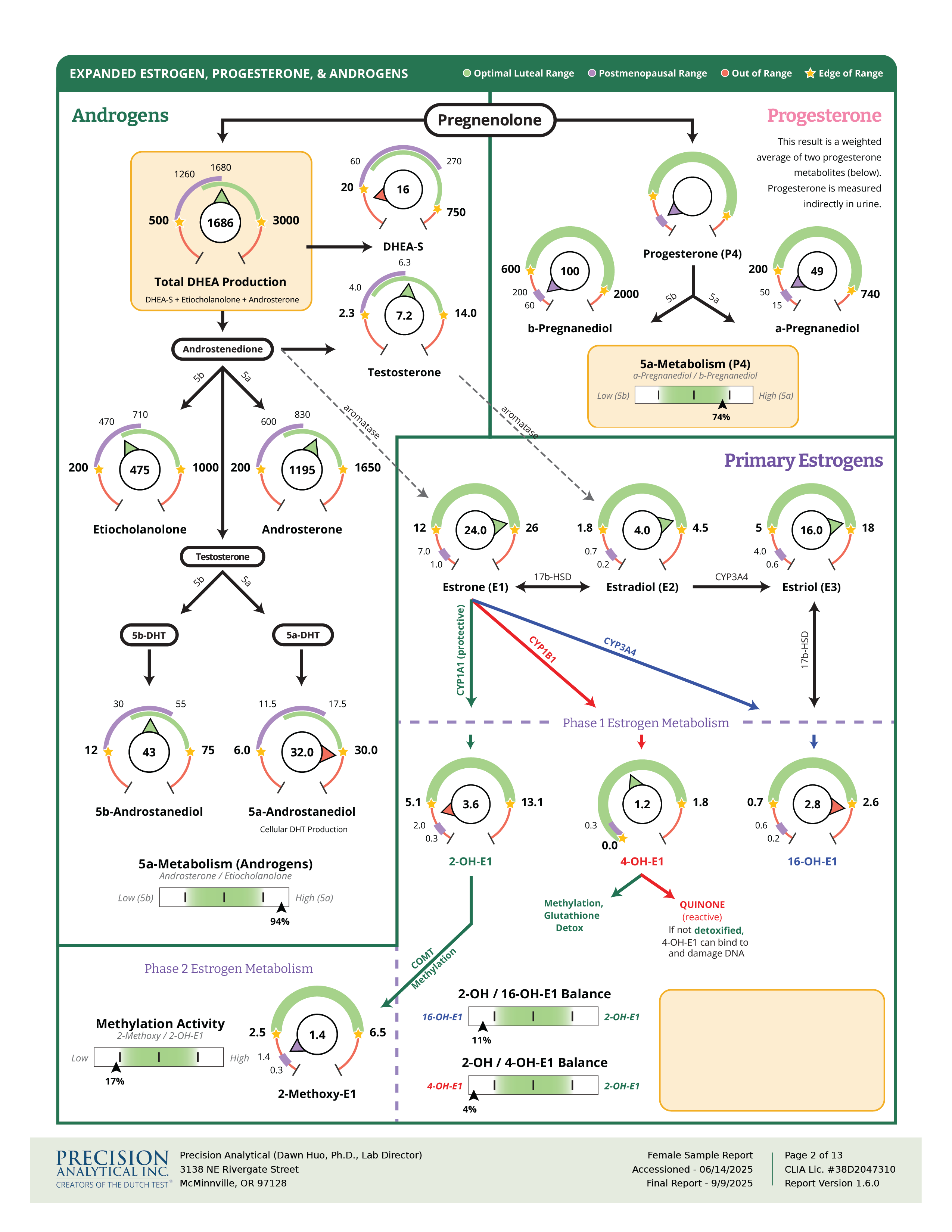
5a-Metabolism (P4) Slider
The 5a- and 5b-reductase enzymes metabolize progesterone into its two main metabolites, 5a-pregnanediol and 5b-pregnanediol. The relative 5a-metabolism of progesterone provides insight into progesterone’s potential for calming and sleep support. This is because 5a-metabolites of progesterone bind GABA receptors in the brain. The new 5a-Metabolism (P4) slider is a calculated ratio that assesses the patient’s potential for 5a-Metabolism. This is most relevant in women who are cycling or taking oral progesterone; therefore, this is only reported in female reports.
Estrogen Metabolite Pie Chart
Next, the Phase 1 Estrogen Metabolism pie chart is retiring! When the DUTCH Test was launched in 2013, a pie chart seemed the best way to visualize the balance between the three phase 1 estrogen metabolites. We know many of you love this DUTCH original. Since that time, however, newer research has highlighted that the potential impacts of the 4-OH-E1 and 16-OH-E1 pathways are best assessed by comparing each individually to the healthy 2-OH-E1, as a ratio. While the pie chart still identifies most issues that can arise with phase 1 estrone metabolism, in certain cases, like when one metabolite is significantly out of range, the balance between the other two ratios can be visually and numerically skewed. The 2-OH/16-OH-E1 and the 2-OH/4-OH-E1 ratios, shown in the slider bars, provide the most clinically reliable, evidence-based information on phase 1 estrogen metabolism, especially in these outlier cases. Most importantly, we needed to conform to the standards of the scientific literature to continue doing what only DUTCH has done – publishing our clinical data in peer-reviewed literature.
We hope you’ve had a chance to read our recent publications on estrogen metabolism, including in Menopause (find it here). We are committed to continuing to improve the evidence that supports our testing. That includes connecting our testing with the body of scientific literature where the relevance of estrogen metabolites is debated and validated. This change represents this commitment and allows for studies (like this one) in the literature to speak more directly to DUTCH measurements.
Total DHEA Production Dial
Finally, the Total DHEA Production dial from the Summary Page is now also shown as part of the androgen steroid pathway on this expanded page. This dial represents the sum of DHEA-S, etiocholanolone, and androsterone, which are each individually reported on this page. These three metabolites represent the total amount of DHEA made by the adrenal glands, an important hormone precursor.
Page 4: Adrenal Hormones & Metabolites
Page 4 of the DUTCH Complete and DUTCH Plus reports displays adrenal hormones and metabolites. We are proud to present new features to the Daily Free Cortisol Diurnal Pattern and Cortisol Awakening Response results. These include changes in colored points (indicating in/out of range), sample-time reporting, additional plotted points, and CAR reporting.
Colored Points on Diurnal Free Cortisol Graph
The points plotted on the free cortisol and free cortisone patterns for all adrenal reports will be highlighted in green when in range and red when out of range. This can help especially when a point is on the border of the reference range, making it easy to see if out of range.
Sample Collection Time Reporting
Both cortisol and cortisone daily patterns on the adrenal reports will show the times the samples were collected across the x-axis, in addition to the header. This helps the provider identify how the patient’s schedule might impact results. The times on the DUTCH Complete are labeled (U) because they come from urine samples, while the times on the DUTCH Plus are labeled (S) because they come from saliva samples.
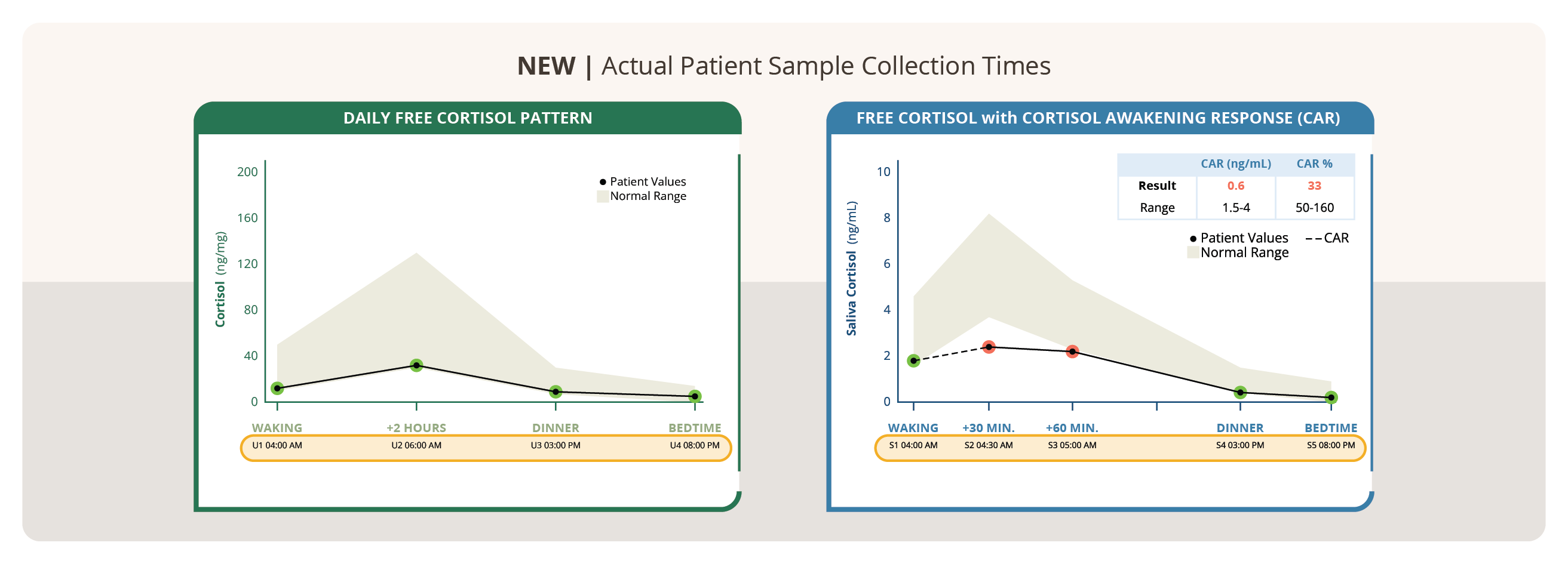
This personalized addition is important because the cortisol results should always be interpreted with the time of day and the patient’s normal schedule in mind.
Additional Samples Plotted
On the DUTCH Complete, urine is used to collect four samples throughout one day to map the free cortisol and free cortisone daily pattern. When patients wake at night and urinate, we ask that they collect a fifth sample, which, in the past, was combined in the lab with the waking sample to calculate a time-weighted average for the “waking” result on the pattern. We are happy to announce that we can now report the individual mid-sleep value, providing more detail directly on the cortisol pattern. 4-point curves will still be reported when patients sleep through the night and return only 4 samples. For those that wake and collect during the night, which is common, reports will include a 5-point curve for both cortisol and cortisone.
The DUTCH Plus has always offered an additional collection tube labeled the “insomnia sample.” The results for this sample were previously reported in a comment below the diurnal curve. Now, the additional sample is reported as part of the free cortisol diurnal graph, when collected. Patients can also collect a sample mid-day, which will also appear in the appropriate place on the daily pattern, when collected.
This represents a change to DUTCH Plus collection instructions! Patients will be encouraged to collect IF they wake during their sleep to assess cortisol’s potential role in insomnia. However, when patients do not wake during the night, directions will now instruct them to collect this additional sample around noon to add a mid-day cortisol assessment to the DUTCH Plus.
Integration of these samples into one diurnal graph streamlines interpretation and allows you to see the entire day’s pattern easily and quickly (see below).
CAR
On the DUTCH Plus, a key feature of the Free Cortisol assessment is the Cortisol Awakening Response (CAR). The CAR is the percent increase from waking to 30 minutes after waking, representing a reflection of the patient’s normal stress response. This measurement is a leading indicator of HPA axis function and is frequently reported in peer-reviewed research studies. Previously, this calculated percentage was shown in the paragraph below the diurnal free cortisol graph. Now, we report the results and calculated percentage increase in the box next to the pattern:
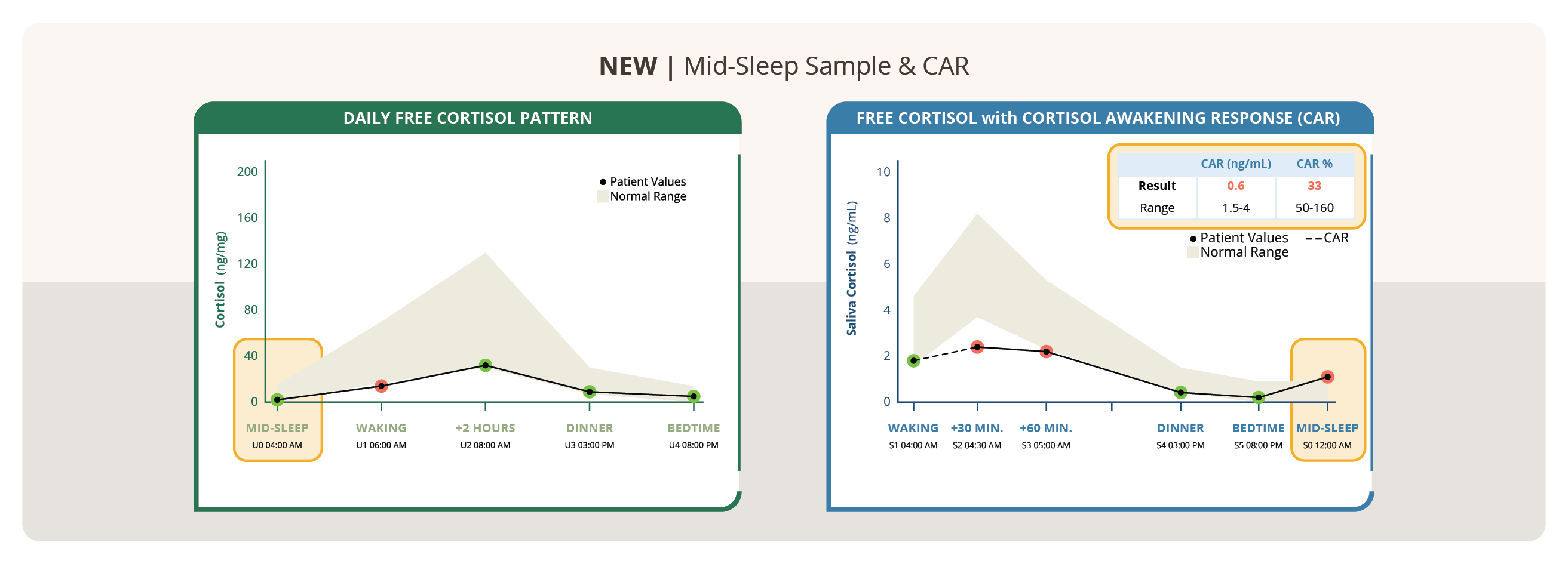
New Feature: About Your Results or “The DUTCH Dozen”
To increase your confidence and help you focus on the key takeaways from the DUTCH report, Precision Analytical has reintroduced comments pages into new pages titled “About Your Results”. These pages provide an interpretive framework to accompany the new Hormone Testing Summary page, including twelve assessments that prioritize the most critical aspects of estrogen, progesterone (for women), androgens, and cortisol balance.
Each “About Your Results” page has four assessments from one of the three sections on the Hormone Testing Summary: Estrogen (and progesterone for women), Androgens, and Cortisol. The patient’s results from each of these sections will display at the top of the page (reported just as they are on the Hormone Summary Page) so you don’t have to flip back and forth. Three sections with four assessments equals twelve, or what we call “The DUTCH Dozen”. You can learn more about the DUTCH Dozen in this focused article, which outlines this amazing new feature of the DUTCH test in more detail.
New: Advanced Insights
Following the About Your Results pages, after the list-style results pages, you will find “Advanced Insights”, educational insights that may provide additional information but may be more complicated to interpret or have a clinical impact that needs a holistic approach.
For practitioners who run DUTCH Tests only occasionally, or do not focus on hormones, we recommend you focus your interpretation using the DUTCH Dozen, which provide the most pertinent and actionable insights from the report. If you wish to dive even deeper (we know many of you love to dive deep into hormones), these additional advanced insights are here to guide you.
DUTCH Trust
The new look, layout, and interpretive framework are designed to simplify and support the quality you have come to expect from Precision Analytical.
We understand that healthcare providers are busy. We have spent an immense amount of time implementing your feedback to design these enhancements. But we recognize that these changes will require you, the provider and patient, to invest in the report. Your time is valuable, and so we have created resources to help you understand the new report:
- Learn more about The DUTCH Dozen
- Read our blog post on the retirement of the Phase 1 Estrogen Metabolism pie chart
- View our report video overviews, Frequently Asked Questions about these enhancements, and more
These changes reflect our ongoing commitment to excellence in reporting. By providing a new Hormone Testing Summary, which offers a more complete overview of the patient’s key hormones all in one page, as well as the new interpretative framework (The DUTCH Dozen), we hope to streamline your clinical assessments. We appreciate you and thank you for joining DUTCH in this improved report!
TAGS
DUTCH Test: Basic Interpretation Resources